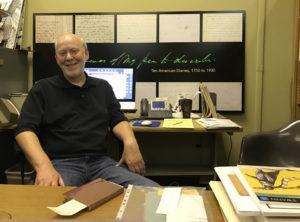The double-sided banner outside of Special Collections invites passersby to pop in and check out the new exhibit, Ingenious Exercises: Sports and the Printed Book in Early Modern Europe, 1500-1800. For the curious who take a moment to stop, they find Domenico Angelo’s L’Ecole des armes (School of Fencing) opened to two fencers demonstrating the proper form to parry against an outside thrust under the wrist, known as a quinte thrust. Angelo’s book is accompanied by other early editions from the Joyce Sports Collection, highlighting various aspects of sports and physical culture including swimming, hunting, wrestling, and football.

Behind the design of Ingenious Exercises is George Rugg, the curator for Americana and the Joyce Sports collections. As curator, George is responsible for the acquisition, care, and interpretation of collections related to the history and cultural heritage of the United States as well as sports and physical culture. He identifies and acquires materials available on the market or from private collectors that relate to existing collection strengths in Special Collections. Once these materials arrive, George ensures that all of the documentation is complete for the library to take physical and intellectual control of the materials. He assesses the condition and works with Hesburgh Library’s conservation staff to determine if treatment is needed to prevent deterioration and to address any special needs to protect the materials. George also researches and interprets the collections in order to help students and visitors understand the significance of the materials, show relationships between them, or contextualize them within our cultural heritage. The main ways he shares this knowledge with students and the public are through teaching classes and by designing exhibits.
Since becoming a curator, George has designed numerous exhibits that feature significant works from the collections. These exhibits cover a range of topics including Civil War manuscripts, Abraham Lincoln, American diaries from the 18th and 19th centuries, baseball literature prior to 1900, boxing literature, and cover art of college football programs. He has also created spotlight exhibits that highlighted the lithographs of the Scottish painter David Roberts (1796-1864), a historical map of the Great Lakes region by the renowned Italian cartographer Vincenzo Coronelli (1650-1718), and the manuscript business records of the Birmingham Black Barons, the elite black professional baseball team.
Also on current display is a spotlight exhibit featuring an important journal George recently acquired that enhances the Colonial Manuscript collection. The Nathaniel Rogers Sermon Notebook contains the sermon notes of Nathaniel Rogers (1598-1655), a Puritan minister who emigrated from England to Massachusetts in 1636. George offers visitors an opportunity to view this rare work while sharing his research on and curatorial concerns for the book. He includes Cotton Mather’s providential history of 17th century New England, the Magnalia Christi Americana (1702), opened to the beginning of Mather’s eulogy of Rogers which provides what little information is known about the minister’s life. George also describes the original condition of the sermon book and the treatments performed by Hesburgh Libraries Preservation to stabilize the notebook so that researchers may safely use it.
For each of these exhibits, George selects materials from Special Collections’ holdings that not only have significance but also capture the imagination. Selected items might represent important works in a bibliographic tradition such as Nicolaes Petter’s Klare Onderrichtinge der voortreffelijcke Worstel-konst (1674). This work is an illustrated self-defense manual that represents one of the finest examples in the tradition of illustrated martial arts manuals, a tradition traceable to a German fencing manual from the 1320s. In the case of the business records of the Birmingham Black Barons, the records provide a look into the history of American baseball in the era of segregation. They document financial transactions between the team and its players during the years when the Black Barons were full members of the Negro National League and before financial pressures generated by the Great Depression forced the team to return to the Negro Southern League in 1931.
George’s current exhibits, Ingenious Exercises and The Nathaniel Rogers Sermon Book, will be on display through December 2016. He will also be giving public tours of Ingenious Exercises on Wednesdays at noon during October and November.
ETA: George Rugg retired from Special Collection in the summer of 2019.
